Breaking into a new role or a new career becomes considerably easier when you take a peek at a particular sales tool. I’ve had a couple jobs with a sales focus, as a sales associate, and I’ve also provided training support to Sales Executives in a couple business-to-business organizations. The only successful way of selling anything to anyone is to understand how your product fills a void or adds value to your customer’s life.
You may already be familiar with the concept of a value proposition, or value prop. If you are, the method that I’m going to touch on is still worth talking about. If value props are on new to you here’s the short version; Regardless of the product or service that’s being sold, it must provide more value to the customer than they need to pay for it. That value might look like more of a good thing or less of a bad thing.
You need to sell yourself to that hiring manager
The problem with some salespeople is that they aren’t interested in the customer at all. They take what they’re selling and try to cram it into their customers lives. This is the wrong way to go about it. A real value prop must begin with the customer. How can anyone proposition value to another without first understanding what that person finds value in? This can only happen once the seller truly understands what problems the customer has and what makes them happy.
Why You Need to Develop Your Own Value Prop
So, what do you care? You’re not in sales. Except you are in sales. You need to convince a hiring manager that has an open job requisition that you are the most appropriate person for that role, regardless of your lack of official experience. You need to sell yourself to that hiring manager and you can only do that once you really understand the problems they are trying to solve.
Once you understand those problems, you’ll be able to identify the various ways that you can help them with those problems. And even better than that, you’ll be able to identify why you’re actually the best candidate to solve those problems.
The Value Prop
During research and development for some sales training material, I found a book created by a group called Strategyzer. The book is called Value Proposition Design. I’m going to use their model for this, and I encourage you to pick this book up. It’s reasonably priced, it’ll help you nail this activity and you’ll even get close to developing a Value Prop activity for a future training program you’ll be a part of. As part of the activity, they layout the elements of a value prop across something called the Value Prop Canvas. It’s a paint-by-numbers sort of thing. I seriously suggest you pick up the book if sales training even remotely interests you. The book walks through this activity in great detail without making it dull.
Part 1: The Customer Profile
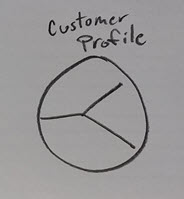
The book approaches this activity from a business development perspective, and they begin by identifying the Customer Profile. In our case the customer is a hypothetical hiring manager. The real trick to this activity is specificity. If you know the company you’re shooting for, the more specific you can get about a customer, the easier and more impactful this activity becomes. We may have to settle for ‘Learning and Development Manager at a mid-size company,” but the more you know about them, the more your value prop will resonate with the manager. Once you have identified who your client is, there are three sections to complete in the Customer Profile, all of which are built around the customer you identified. The answers to the following questions can come from a number of places, ideally the actual customer. Since you might not have the ability to ask them these questions, you can make an educated guess with a bit of research. The more information you have, the easier it will be.
Customer Jobs
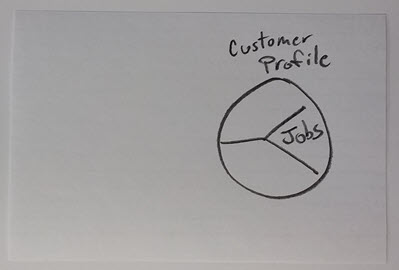
This is where you list out all of the jobs and tasks that an L&D manager needs to accomplish. A job description for the role you’d like would be helpful, since they have an immediate need to solve those problems, but you might want to take a few minutes and read between the lines. In my experience, job descriptions are about 60% accurate to what actually needs to get done. And then there are political battles, and team dynamics to consider.
Pains
I like to think of this section as ‘friction points.’ What are the real challenges that they face? What slows down their production? What are the challenges that come with their learner groups? Do they have a limited budget for ‘extras’, like stock images sites or voice over artist?
Gains
What makes them happy? What are the things in their life that they get a real high out of? What does success look like?
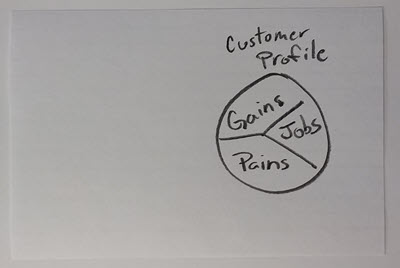
As you can see, if you have a specific person in mind you’ll have an easier time answering these questions. Once you have answers to these questions, you’ll be able to look at your own collection of experiences and available tools to see where you can help.
Part II: The Value Prop
The questions around the client aren’t really the value prop, but they’re needed to successfully identify what our value prop is; Making our own little paint-by-numbers situation.
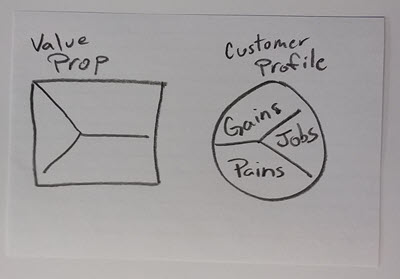
Products & Services
This activity is built for business development, and we need to bend the mould a bit to fit our L&D career kick-off. Instead of Products and Services, here is where you’ll write down anything that you have in your tool kit that remotely relates to what was identified on the hiring manager’s side. Any notable corporate experience, volunteer work, media production, public speaking, problem solving, colouring contests, etc. Listing it all out is important to make the best possible connections but even if you list it here, it might not make it into the final value prop.
I really encourage you to take your time with this. Literally take a couple of days and get it all out there. We are the sum of our experiences, and by taking the time to reach back into the far recesses of your mind, you are literally presenting more potential value. High School Film club experiences might be a throw-away in your mind, but in the right place at the right time, it might be something that your competition doesn’t have.
Pain Relievers
This is where the dot-connecting begins. Focus one eye on the Pains section, looking at the friction points that the hiring manager has. Now with other eye, look at your Products & Services section. Now, look at the experiences you’ve had and see if they can reduce or eliminate an item on the pain list. Does your experience with cold-call fund-raising give you the ability to build instant rapport with learners? Did you take an improv class that helps you think on your feet when you need to troubleshoot tech if it goes down during a demo? We now see that your ability to get answers during the Customer Profile exploration has a direct impact on your ability to make strong and relevant connections in your Value Prop.
Gain Creators
You can probably guess how this section needs to be completed. Using the Gains section from the Customer Profile, you look at your Products & Services to see how you can make the Gains even gainier. If the hiring manager wants to provide learners with a well polished visual presentation, maybe your part-time experience as an art teacher gives you a better command over visual communication.
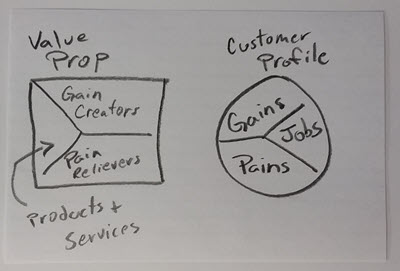
Don’t expect to have an apples-to-apples fit between the hiring manager’s needs and your abilities. That may never actually happen. Ever. But if you understand this model and you sincerely inquire into the hiring managers challenges and hopes, you’ll connect your experience to their needs in a way no other candidate will.
How and When to Use This Tool
I’d encourage you to use this in a couple of different ways. You most likely won’t be able to develop this for a specific person but you’ll be able to get close based on what you know of the world.
Part I: Practice
Create a ‘hiring manager persona’ so you can make a tailored value prop for a specific fictional person. That would be more valuable than creating a generic one. Specificity is key, even if it’s not true to life. This is the opportunity for you to tie as much of your relevant experience to an employment gap as possible.
Part II: Game Time
With that trial version done, you can create a sheet using the format seen above but without the lines. On the far left, where you’d normally see Products & Services, write shorthand versions of every possible thing of value you have ever done in your entire life. Wedding videos, charity runs, scared straight talks that you’ve attended. Everything.
Take that to the interview with you. Find the opportunity to ask some questions. Those questions could fall pretty close to the questions that are part of the Customer Profile side of the value prop canvas. You then address their needs with various experiences that you’ve had. This can often feel like a bit of a needs assessment, as well. Nothing wrong with that. Find a gap. Bridge the gap.
So, What’s Your Next Step?
- Get familiar with the value prop format
- Buy the book
- Search ‘value prop design’
- There are tons of blog posts and videos
- Create a Hiring Manager Person, with all the details
- Make a shorthand list of all of your relevant experiences